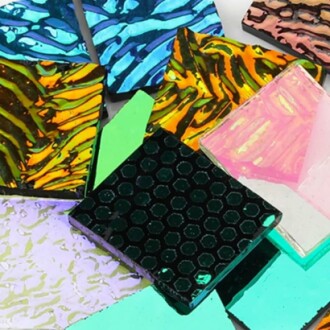
Harnessing the Power of Dichroic Glass in Your Art
- Dichroic glass presents unique color-changing effects that can elevate your art.
- It is versatile for various glass crafting techniques, particularly in jewelry making.
- Using dichroic glass can enhance designs with depth and texture.
- Explore different project ideas to harness the creative energy of dichroic glass.
- Discover where to find quality dichroic glass supplies.
Dichroic glass is a captivating material that can take your glass art projects to new heights. Known for its vibrant colors and unique optical properties, this type of glass can change shades depending on the angle and light. Whether you are a beginner or an experienced artist, incorporating dichroic glass into your work can open a world of creative possibilities. In this article, we will explore how to effectively use dichroic glass in art projects and provide guidance on selecting the right supplies.
What is Dichroic Glass?
Dichroic glass features multiple layers of metal oxides, providing stunning color shifts when viewed from different angles. The term "dichroic" comes from the Greek words meaning "two colors," which perfectly describes its unique characteristic of displaying different colors based on the viewing angle. This glass is often used in jewelry making, decorative glass art, and other creative projects due to its striking visual effects.
Benefits of Using Dichroic Glass
- Visual Appeal: Creates eye-catching designs and enhances artistic expression.
- Versatility: Suitable for a variety of projects, including jewelry, ornaments, mosaics, and more.
- Easy to Work With: Can be cut, shaped, and fused like standard glass.
- Diverse Options: Available in an array of colors, shapes, and sizes to fit different artistic styles.
Project Ideas Using Dichroic Glass
There are numerous creative ways to utilize dichroic glass in your projects:
- Jewelry Making: Incorporate dichroic glass in pendants, earrings, or other accessories.
- Glass Fusing: Layer dichroic glass with other glass types to create stunning fused pieces.
- Decorative Art: Use as embellishments in glass art pieces for added texture and dimension.
- Functional Pieces: Create unique coasters, dishes, or tiles that stand out.
- Mixed Media: Combine with other media to add a pop of color and intrigue.
Products to Consider
When venturing into the world of dichroic glass, quality supplies are essential. Here are two top products to consider:
3bags COE90 Dichroic Glass Scrap Assorted Fusible Glass
Unleash your creativity with assorted dichroic glass pieces, perfect for jewelry making and other glass projects. Create unique effects with random colors and shapes.
Learn MoreHow to Use Dichroic Glass
To achieve the best results with dichroic glass, follow these tips:
- Experiment with different layering techniques to maximize color effects.
- Always consider the firing schedule when using in a kiln.
- Use safety gear when cutting or handling glass.
- Start with small pieces to get a feel for how they behave in the kiln.
Where to Buy Quality Dichroic Glass
Finding high-quality dichroic glass is a crucial step for any artist. Here are some reliable sources:
- Explore our range of glass sheets and supplies.
- Find essential fusing and slumping supplies.
- Browse various glass molds that complement your work.
- Check out quality casting supplies for advanced projects.
- Invest in reliable kilns designed for all glass-making needs.
Conclusion
Dichroic glass is more than just a beautiful material; it is a powerful tool for artists looking to enhance their work. With an array of colors and the ability to create stunning visual effects, using dichroic glass can significantly transform any project. By experimenting with various techniques and incorporating quality materials, you can truly harness the creative energy that dichroic glass offers.
Pros
- Stunning visual effects that capture attention.
- Easy to manipulate and incorporate into various projects.
- Available in a wide array of colors and shapes.
- Inspires creativity and artistic expression.
Cons
- Can be more expensive than standard glass materials.
- Requires practice to master effective use in projects.
- May need special care to maintain its appearance.


